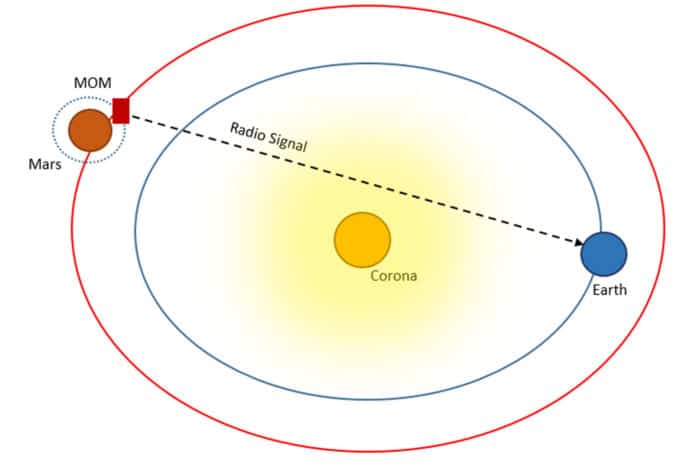The reason behind the high temperature of the solar corona is still a mystery. The solar wind emerging from this region passes through the interplanetary spaces and forms the magnetosphere of the planets. It also affects the near-Earth space environment through a phenomenon known as “Space Weather.”
Due to its intrinsic turbulence, solar wind is a dispersive medium for an electromagnetic radio wave passing through it.
To study the solar corona, scientists used S-band radio signals coming from the Indian Mars Orbiter Mission (MOM). The team includes scientists from the Space Physics Laboratory of Vikram Sarabhai Space Centre, Trivandrum; Physical Research Laboratory, Ahmedabad; and ISRO Telemetry Tracking and Command Network (ISTRAC), Bangalore.
Solar conjunction is when Earth and Mars are on the opposite sides of the Sun. The event usually happens once in approximately two years for Mars. During this event, the radio signals from MOM pass through the solar corona, as close as ten solar radii (1 solar radius (Rʘ) = 696,340 km = about 100 Earth radii), from the center of the Sun. It hence, provide a unique opportunity to study solar dynamics.
Using the conjunction event of May-June 2015, scientists studied the turbulence in the solar corona. They found that the transition of solar wind from sub-alfvenic to super-alfvenic flow occurs around 10–15 Rʘ during the low solar activity period.
The radio signals from MOM spacecraft crossing through the solar corona during the conjunction event consequently experience dispersive effects. The turbulence causes fluctuations in plasma density, causing fluctuations in the phase of radio waves passing through it.
Thus, the radio signals received at the ground station (Indian Deep Space Network, ISTRAC for MOM) contain the signature of propagating medium. The detailed analysis could offer the turbulence spectrum of the medium.
MOM uses the coronal radio-sounding technique to study the coronal regions spanning maximum and minimum phases of different solar cycles.
By spectrally analyzing the Doppler frequency residuals from radio signals, scientists obtained a coronal turbulence spectrum at heliocentric distances between 4 and 20 Rʘ.
The scientists found that the turbulence power spectrum at a lower heliocentric distance (<10 Rʘ) has flattened at shorter frequencies with a smaller spectral index, corresponding to the solar wind acceleration region. Smaller spectral index values closer to the Sun’s surface signify the energy input regime where turbulence is still underdeveloped. For more considerable heliocentric distances (> 10 Rʘ), the curve steepens with a spectral index close to 2/3, indicative of the inertial regime of developed Kolmogorov-type turbulence, where energy is transported through cascading.
This finding is consistent with those of theoretical models of solar wind turbulence. The first direct observation of solar corona by Parker Probe also supports this finding.
Journal Reference:
- Richa N Jain et al. A study on the solar coronal dynamics during the post-maxima phase of the solar cycle 24 using S-band radio signals from the Indian Mars Orbiter Mission. DOI: 10.1093/mnras/stac056
